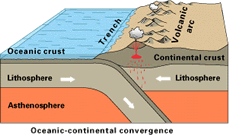Destructive Plate Margin
Volcano Learning zone > Volcano Glossary

Destructive margins and Subduction Zones occur where two plates, one of which must be oceanic, converge due to plate movement. As oceanic crust moves away from the mid ocean ridges it gets cold and dense. Eventually it will sink back into the mantle underneath a neighbouring plate (continental or oceanic) forming subduction zone. As it sinks back into the mantle fluids are released which cause melting in the wedge of mantle above. The molten rock gradually rises towards the surface through cracks and weaknesses in the crust above. Eventually it collects in a magma chamber from which it then erupts as a volcano.In this way continental volcanic arcs such as the Andes and Island arcs such as the Aleutians are formed.
The Pacific ring of fire is a near circular chain of volcanoes which borders the Pacific Ocean it is formed by a near continuous Subduction Zone from Chile , through the Cascades,Alaska,Japan, the Phillipines Indonesia and New Zealand.

The magma the volcano produces will be quite "sticky" or viscous due to high levels of silica picked up from the crust on the ascent and from fractional crystallisation. This is where more siica rich minerals crystallise out first as the magma cools in the magma chamber.
Subduction zone volcanoes are often called strato-volcanoes or composite volcanoes because they erupt a mxture of lava an ash. Eruptions are usually explosive. The Andes give their name to Andesite the rock type which is the predominant volcanic rock type. Rhyolite,Dacite and occasiionally basalt are also erupted.


